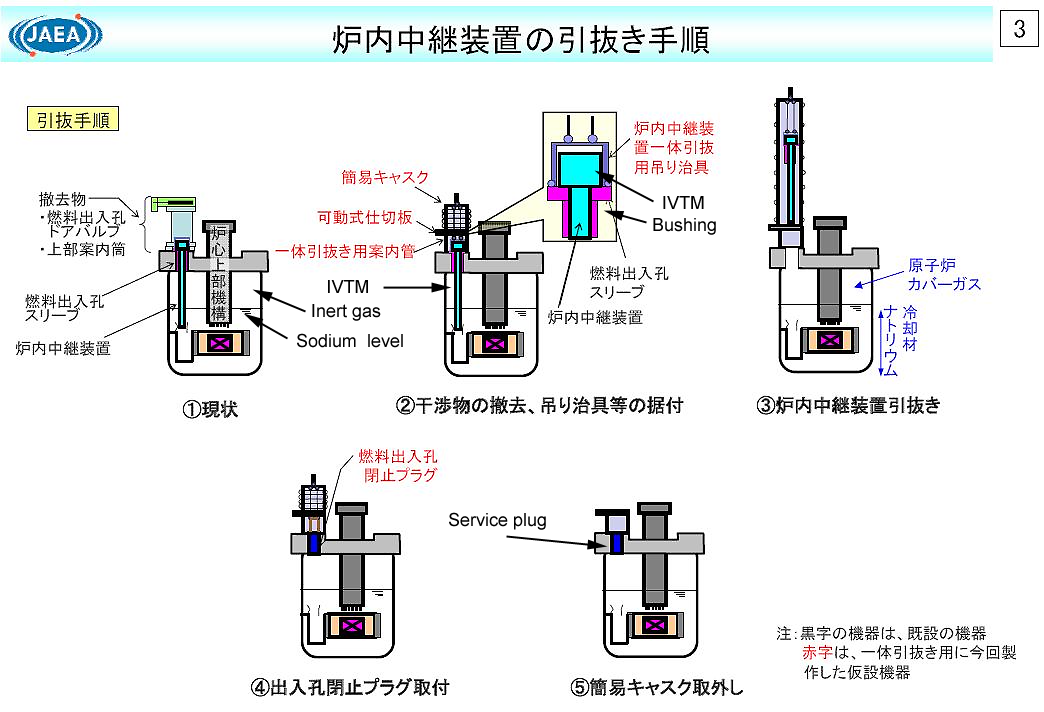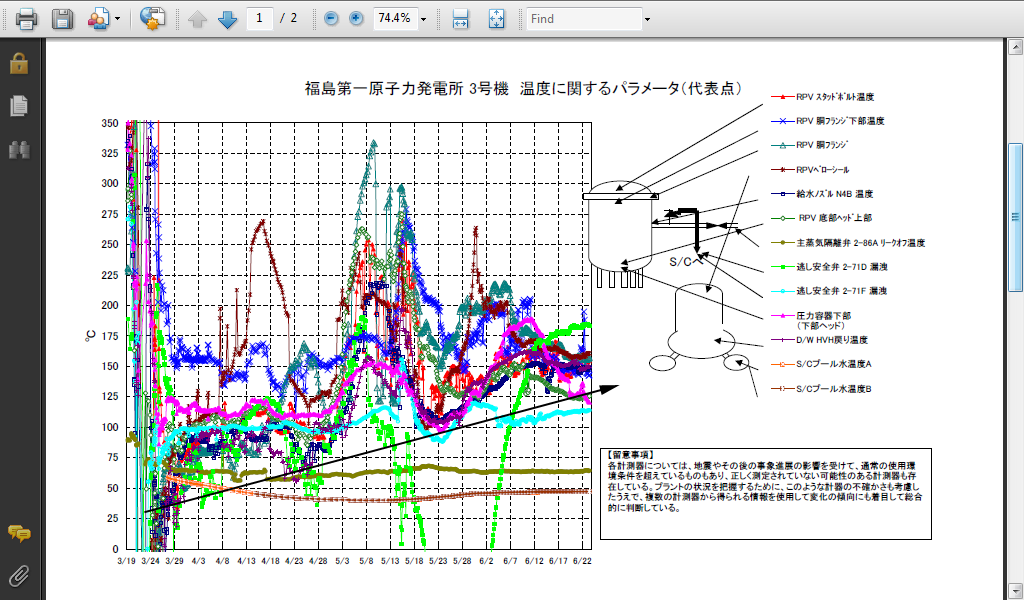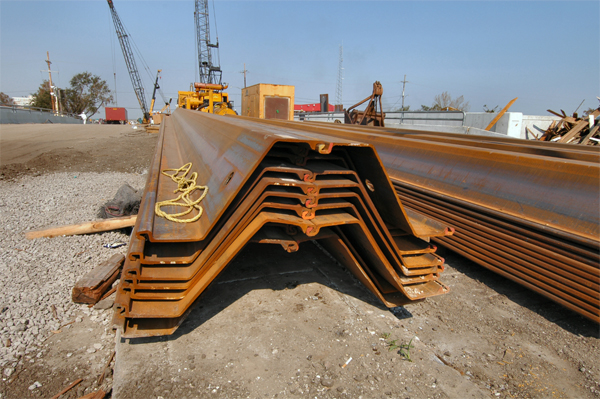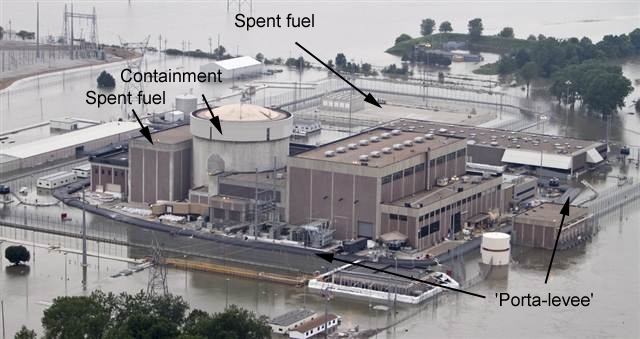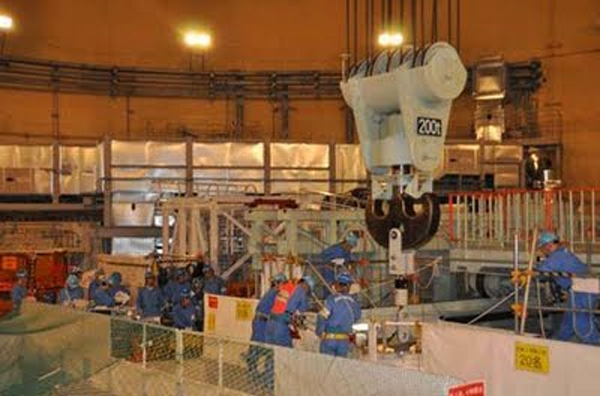Right about now — the 23d of June — the Japanese are in the process of attempting to remove the in-vessel transfer machine from the fast reactor at Monju. According to the reactor operator by way of Estimable Ex- SKF, they are going to remove the bushing in the reactor vessel lid that the transfer machine fits into. Operator believes the added clearance obtained by removing the bushing along with the machine will allow the damaged business end of said machine to retract clear of the lid.
Pucker Time! There are a lot of things that can go wrong w/ catastrophic outcomes:
– The bushing keeps the inert argon gas within the reactor vessel and separate from atmospheric air in the building. The operator’s task is to remove this bushing while keeping air out of the reactor, where it would violently react with the sodium moderator with (potentially explosive) consequences.– The pantograph may be damaged to the degree it cannot be retracted even with the bushing removed. This would require removing more of the reactor lid or disassembling the machine inside the reactor vessel without disturbing the core or coolant.
– The reactor is ‘hot’ even though it is not operating: the control rods are fully inserted. The moderator is in a liquid state. (Note: liquid metal- moderated reactors are generally not pressurized.) Fussing with the machine might effect the core, which in turn would need attention with the machine right in the way!
– Removing the machine might damage the core: the machine might also fall again with parts breaking off inside the vessel.
– Inert argon gas in the reactor is not toxic but is asphyxiating. Argon flooding the operating side would be disruptive to the crew working on the reactor at the place and time where a functioning crew is absolutely required.
– There may be something else wrong inside the reactor vessel that the operator doesn’t know about because the core cannot be inspected.
The main hazard is the sodium. If air enters the vessel the operator will have seconds to reinsert the plug and the transfer machine to smother the reaction while pumping in more argon. A ‘fire’ in the reactor would contaminate the sodium which would probably require removing the fuel — by way of a replacement fuel transfer machine — then draining the sodium. The inside of the reactor, the core, the primary cooling circuit pumps, heat exchanger and the circuit piping would have to be cleaned of oxides and other reaction byproducts.
A fire would also require a redesign of the fuel transfer machines, reactor lid and possibly the core. The reactor would be shut down for another ten or fifteen years. It would probably be the end of the $12 billion reactor itself. Like the rest of the world, Japan is broke.
All of this leaves out the chilling effect of Fukushima meltdowns on industry ‘ambitions’. This reactor needs to be shut down and scrapped as the next step after removing the in-vessel transport. Monju cannot reprocess new fuel from the waste from other reactors, only convert U-238 into a relatively small amount of plutonium. There is far more plutonium waste within the spent fuel pools at Rakkosho reprocessing ‘plant’ than Monju can produce in years of maximum production (Click on pic for big).
Figure 1: a diagram of what is taking place (Japan Atomic Energy Agency by way of Ex-SKF). What is likely to happen is:
– the operator is able to retrieve the machine safely. If this happens there will be industry pressure to fix the machine or bring forward another and restart the reactor.– the operator cannot retrieve the machine: the effort is canceled and a ‘Plan B’ devised.
The ordinary Japanese citizens need to get off their butts and start agitating against the industry/government agency duopoly which has (almost) fatally compromised the country. One way or another the Duopoly will be held completely accountable for messes so far created and those sure to come. The Japanese have no choice but to put the fire to the administrators. Time is running out: the notable ‘patience’ of the citizen needs to be replaced by a sense of urgency.
Heads need to roll, some folks need to ‘go to jail, go directly to jail, do not collect $200’.
Japanese (and the German, French, Americans, Russians, etc.) cannot run away or migrate or ‘escape’ from the reactors or reinvent themselves on some level which escapes the follies of central governance. To do so, to believe that some sort of miniature civilized society can be built around the putative ruins of these reactors is magical thinking. Radiation makes the rules and the centralized problem requires a top- down, big government centralized solution. Only governments — with the ability to marshal vast resources and direct them over long time periods — can control, manage and safely remove the reactor hazards.
Just as big governments are the only entities that can manage nuclear weapons and their safe disposal. Reactors and nuke weapons are identical. They must be treated identically or the destructive consequences of their existence will inevitably emerge.
In ‘finance speak’ there is a duration mismatch between the time demands of reactor management made by radiation physics (centuries) and the duration of human institutions (decades or less).
Monju lies on top of a major earthquake fault, right by the Sea of Japan (facing China). Here’s a video from inside the plant. For those who don’t understand Japanese (including me) the video is self- explanatory. There are snips of the 1995 sodium leak and fire that shut the plant for 15 years (click pic to enlarge):
(Asahi by way of Ex- SKF):
About 3 minutes and 30 seconds into the documentary, a local councilman shouts at the Monju operators after the sodium leak and fire accident in 1995: “A courage to climb the mountain? You need a courage to quit, you idiot!”About 10 minutes into the documentary, you get to see the inside of the Containment Vessel of Monju. Brightly lit, cavernous hall. We cannot assume the safety of the reactor, but if there is no radiation leak, it means it is safe, says the engineer.
17, 18 minutes into the documentary, you see the public buildings built by Tsuruga City with the money from the government for having nuclear reactors. The documentary then shows the local fishermen reluctant to say anything about Monju. One elderly man says “Safe, of course it’s safe.” One elderly woman says “I can’t answer anything”, when asked about the nuclear accident in Fukushima.
Despite the hype, the reactor industry does not flourish due to excellence of its product. Electricity is electricity and can be had from many sources: solar, wind, geothermal. The diminished amounts other sources make available can be adjusted to. There is no inherent human need for maglev bullet trains or parking garages illuminated 24 hours a day.
Instead of meeting a need, the need is maneuvered around: industry pays bribes in order to divide communities. Those that divide become ‘reactor villages’. The divided communities in turn become dependent upon the bribes and the multiple reactors that accompany them.
Meanwhile, the situation at Fukushima Daiichi continues to slowly and surely deteriorate. The temperatures in reactor unit 3 continue to steadily increase, with temperature pulses indicating reactivity taking place in what remains of the core. How can this happen if the core is an unstructured blob without a moderator?
I don’t know but the increase in temperatures speaks for itself. At 12 tons of water into the reactor per hour — much higher than at the other reactor units — there is sufficient cooling to overcome decay heat. Something else is going on in reactor unit 3 and TEPCO cannot control it (click pic to enlarge).
Figure 2: Dumping water in one end means water coming out the other. The flood in reactor basements is about 150mm (6 inches) from us out here. In a few more days the water will start flowing into the Pacific Ocean — in addition to the water that is already flowing into the Pacific Ocean from places where it cannot be seen!
The water treatment equipment that has been installed at reactor unit 1 to strain isotopes from the wastewater is not working properly. The plan has been to strain out the rads and pump the water back into the reactor to reduce the new water added to the amounts flooding the complex’ basements.
The treatment cannot work: material strained from the water is extremely radioactive. At some point the water- straining equipment will become too radioactive to approach. Then what? Maybe the material strained and the equipment can be ground up pumped back into the reactor as well. This is the ‘Tao of Rads’. They cannot be escaped or negotiated with. The radiation and the water needs to be confined in the containments.
Water leaks from holes and cracks in the reactor buildings into the ground carrying radiation with it.
TEPCO needs to start adding solids into the reactors: boron, bentonite clay (which would stop the leaks from the containments), sand, lead … at some point concrete. These can be pumped in with the water. Boron is a reactor poison that would stifle some the reactivity in the core(s). In units 1 and 2, these are likely of fission daughter isotopes: decay heat. Sand and clay would slow or stop the flood of water into the ground through cracks and holes. Solids don’t flow and can shield the radiation.
TEPCO also needs to get off its collective butt and build a sheet- piling cofferdam around the reactor campus, Sheet piles are interlocking steel plates that are corrugated lengthwise to give them rigidity. They can be vibrated into the ground to the bedrock to keep water in the soil under the plant. The piles are caulked shortly before driving them to keep water from seeping between adjacent piles. Using these piles is a commonplace technique for building seawalls, revetments and bulkheads. A cofferdam could be built around Fukushima within weeks without exposing workers to radiation. A cofferdam should have been started once radiation was discovered in seawater outside the cooling outflows, once management knew water was leaking out of the reactors.
Here are sheet piles in New Orleans post-Katrina . The cranes in the background hoisted the pilings up and vibrated them into the ground to form a water- resistant palisade.
Figure 3: (US Army Corp of Engineers photo)
Reactor buildings are … buildings. A compromised structure deteriorates rapidly, much faster than an integrated one that is well- maintained. The four reactor buildings have been compromised by the earthquake, by the shifting/liquefaction of earth under the foundations, the tsunami, the explosions, by high heat and intense radiation, fires and exposure to corrosive elements. As is usually the case with compromised structures, they fail catastrophically with no warning.
A good example is the three large towers that made up the World Trade Center.
The extreme radiation prevents necessary maintenance and inspections. The emissions expose structure elements to stresses they were not designed to carry for more than short periods. The radiation is a reason why the buildings appear to be deteriorating day by day.
The large amounts of highly- radioactive water in these buildings are effecting the structures in ways that are hard to determine. Reactors have never before been flooded as these have been for extended periods. The water being poured into the buildings is saturating the soil under the buildings. The reactor structures are fractured with cracks and holes. The longer these reactors are filled with ‘hot’ water, more likely something important will break. A shift of a few inches by a vital component will be enough to cause a cascading series of structural failures.
The failure of one building would lead to the inevitable failure or abandonment of the others. The buildings now are too ‘hot’ to work on or in, even for the press- ganged Barakumin whom Yakuza ‘sub- contractors’ dredge up to feed into the radioactive meat grinder..
These reactor buildings are immensely heavy and loaded with tons of spent fuel in open tanks. This represents potential energy needing only a ‘moment’ to release: a tiny structural overload somewhere hidden in a basement or underground. Nobody will discover this ‘overload’ until after it has rendered repair or adjustment impossible.
Meanwhile, in the American Heartland, the Fort Calhoun reactor is having its trial by water as the Missouri River slowly claims it.
There are several issues with this reactor along with others that line the Missouri and Mississippi rivers downstream.
Calhoun is shut down and the fuel has been removed from the pressure vessel into a spent fuel pool. This reactor is a pressurized water reactor unlike those at Fukushima Daiichi or the Cooper nuclear station that is also facing the flood.
Figure 2: Ft Calhoun reactor showing two spent fuel locations. The more radioactive core material is located in a secure (from flooding) service building adjacent the containment. (Nati Harnik photo, AP) The spent fuel lagoon in the background is surrounded with an earthen levee. The plant itself has earth and concrete barrier along with a inner ‘porta- levee’ which is a giant neoprene tube that is filled with water. You can see the tube surrounding the plant in the photo.
Reactor and spent fuel layout is otherwise similar to the boiling water reactors.
The core and the in-reactor spent fuel pool in a boiling water reactor which are above ground, both are accessed at the service deck. As with other PWRs, the pressure vessel and the spent fuel pools @ Ft. Calhoun are at ground level. Both pool and vessel are in buildings that are gas/water tight, as part of ordinary design. Air pressure in the main reactor buildings is reduced to keep dust and gases within the reactor. The building can keep river water outside for an indefinite period.
Not so the support structures and the ‘main’ spent fuel pool that contains hundreds of tons of fuel assemblies. This pond along with its cooling system are next to the reactor building covered by a flat cement lid. There are two problems:
– the river can flow over/under/sideways/down past the temporary levees and flood the pit, effecting the cooling for that pit. The water- tightness of the cooling equipment building and its electrical components is unknown.– The fuel assemblies are cooler than those in the containment and they would indeed be underwater. However, the reactor’s spent fuel would be directly connected to the river. Some radioactivity would escape into the water and be carried downstream.
– As per reactor usual, there is no way for the operator to access this fuel to ‘move’ it somewhere/nowhere.
The problems of high- current cables and switchgear being in (flooded) basements and inaccessible is not really a problem with this reactor. The equipment for maintaining the in- reactor spent fuel is also secure with outside power available by way of towers, underground cables with backup available. If the water becomes deep enough the operator can bring even more power to the site on a barge.
The Cooper reactor is more problematic because it is a boiling water reactor (BWR) like those @ Fukushima with similar undersized containment issues. Right now, the reactor is operating at full power. The utility operator is watching water levels. This reactor has flooded before. If cooling is hazarded the plant will be shut down, the issue will then be maintaining cooling to remove decay heat.
Interesting comment by EX- SKF:
“There have been doubts expressed whether the operation is technically feasible.”
No explanation or source by EX- SKF for this remark.
The machine lift does have a certain ‘pulling yourself up by your bootstraps’ aspect.
Here’s a JAEA photo:
The original lift attempt made use of the hoist, whose hook is @ the center of the pic; to lift by main force. JAEA canceled when they feared breaking the reactor. It would not be surprising if the pantograph arm is fully extended into the vessel, with instruments indicating otherwise.
UPDATE 2: JAEA reports the machine was successfully retrieved. Now they can use it to shut down the plant permanently.
…
